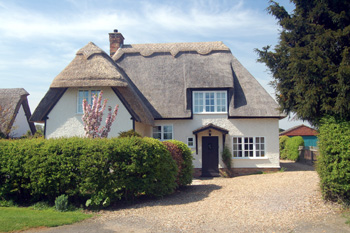43 Thorncote Road Northill

43 formerly 18 Thorncote Road April 2009
43 Thorncote Road was listed by the former Department of Environment in March 1985 as Grade II, of special interest. The department dated the property, formerly a pair of cottages, to the 18th century. It has a timber framed construction with
a colour washed roughcast rendered exterior and half-hipped thatched roof, beneath lies one storey and attics, gable end to road. In recent years the properties on Thorncote Road have all been renumbered. 43 Thorncote Road was formerly Numbered 16 and 18.
In 1910 a thorough rating valuation was carried out across England as part of David Lloyd-George’s pioneering 1909 budget. The survey was so thorough it was known colloquially as the Domesday Survey. The results show that all the older buildings in Northill were owned by John Edmund Audley Harvey, who, though he lived in London, was Lord of the Manor of Northill as well as Lord of the Manor of Ickwell and owner of Ickwell Bury. These older buildings may have been built by a former Lord of the Manor or bought by the Manor at a later stage – detailed research of the Harvey [HY] archive would be needed to try to establish this in each case, unless the current owners still have the deeds to the properties concerned and so can research the history for themselves.
The Rating and Valuation Act 1925 specified that every building and piece of land in the country was to be assessed to determine its rateable value. Northill was assessed in 1927 and the valuer visiting the property [DV1/C45/17] found it owned and occupied by John Marshall. Either he or a predecessor had evidently bought it from the Harveys after 1910 but whether by public auction or private treaty is not known. The cottage stood in about a quarter of an acre and then stood wholly gable end on to the road as the extension to the north is modern.
The “good” accommodation comprised a living room, kitchen and scullery with two bedrooms above. A coal barn, wood barn and earth closet stood outside and mains water was laid on to the house. The valuer commented: “good garden”.